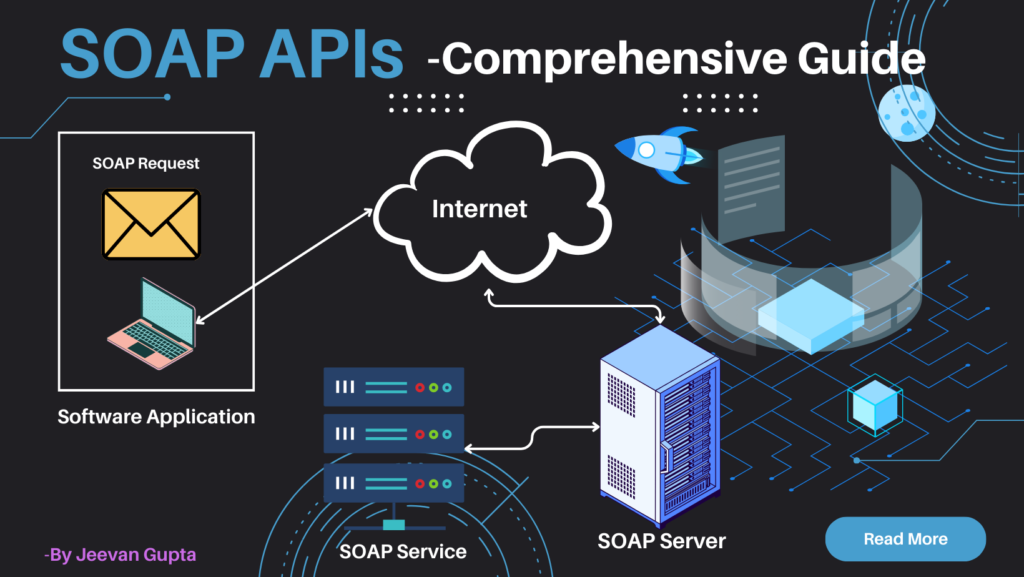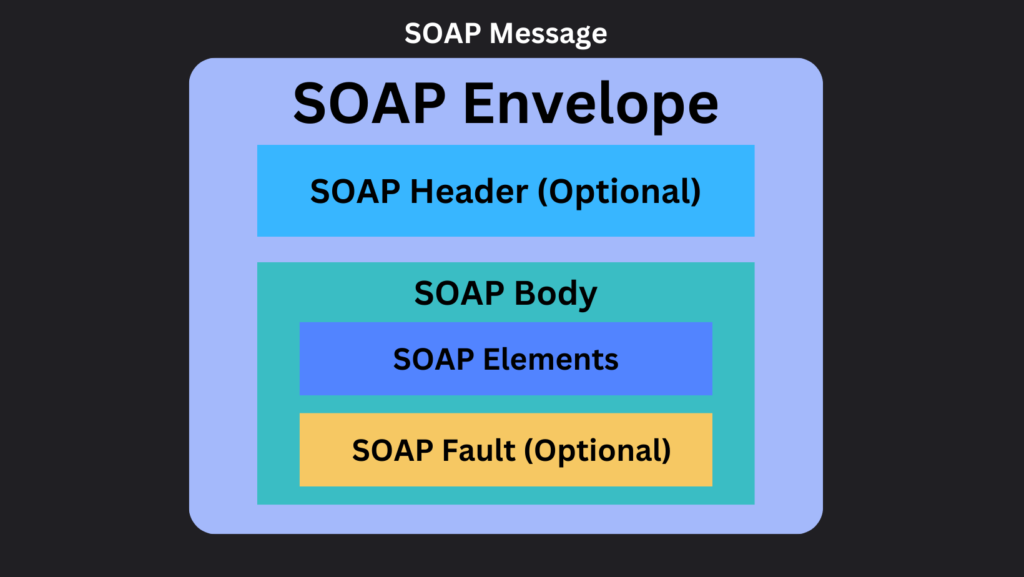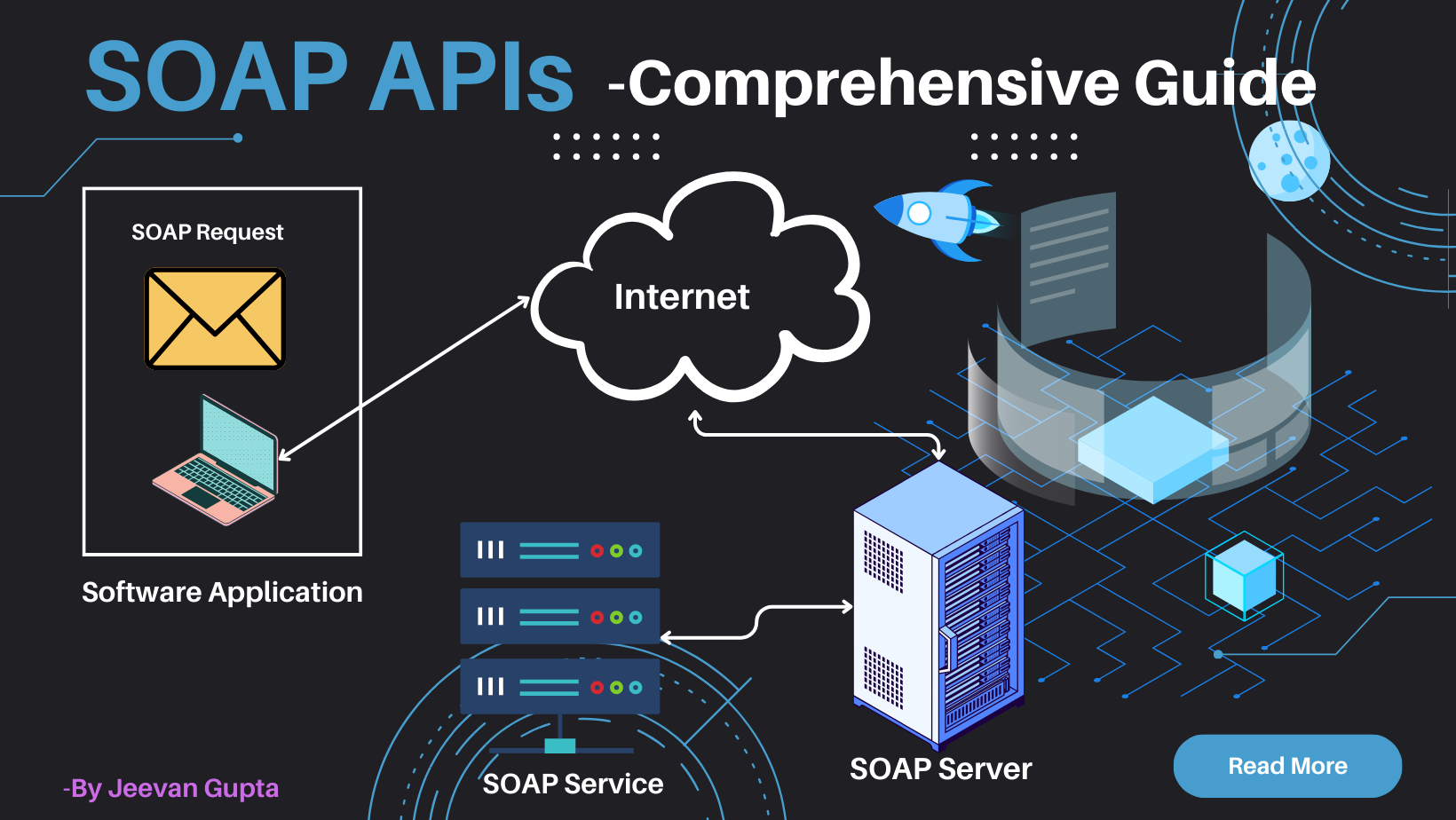A comprehensive guide to SOAP APIs
Welcome to my comprehensive guide on SOAP APIs – your ultimate resource for unraveling the intricacies of Simple Object Access Protocol (SOAP) APIs. In this article, we will delve into the understanding of SOAP APIs, their features, workings, advantages, limitations, examples, and FAQs. Whether you’re a seasoned developer, a tech enthusiast, or a business professional, this article is for you. Let’s dive in.

What is an API?
An API stands for “Application Programming Interface”, a set of rules and protocols that allows different software applications (components) to communicate with each other. It defines the methods and data formats that applications can use to request and exchange information. APIs act as bridges, enabling seamless integration between diverse systems, services, or platforms, and facilitating data sharing and functionality. APIs play a crucial role in modern software development by enabling developers to leverage existing functionalities without having to understand the internal workings of the systems they interact with or reinvent the wheel.
What is SOAP API?
SOAP APIs, or Simple Object Access Protocol APIs, provide a standardized protocol for exchanging structured information in web services. They are based on XML (eXtensible Markup Language) and use the SOAP protocol for communication.
Simply put, “It is a messaging protocol that allows programs running on different operating systems to communicate with each other using XML”. SOAP APIs offer robustness, security, and compatibility across different platforms and programming languages.
Characteristics and Features of SOAP APIs
Extensibility: SOAP APIs can support additional functionalities by adding new SOAP headers or XML elements to the envelopes. Headers can be used for security, transaction management, and other purposes.
Security: SOAP APIs provide built-in security mechanisms, such as WS-Security, (encryption and digital signatures), ensuring the confidentiality and integrity of data.
Reliable messaging: SOAP APIs support reliable messaging through features like acknowledgment mechanisms, ensuring the delivery of messages in the correct order.
HTTP or SMTP as Transport Protocols: SOAP messages are typically transported over standard protocols such as HTTP or SMTP. When using HTTP, SOAP messages are sent as an HTTP POST request payload. SOAP can operate over TCP protocols too offering flexibility.
Stateful or Stateless Communication: SOAP APIs can support stateful and stateless communication. Stateful communication involves maintaining session information between requests, while stateless communication treats each request independently.
Error Handling: SOAP defines a standard way to handle errors through fault elements in the XML response. This allows the server to communicate error details to the client in a structured manner.
Interoperability: SOAP is designed to be platform-independent and language-neutral, promoting interoperability between systems built on different technologies.
WSDL (Web Services Description Language): WSDL is used to describe the functionality offered by a SOAP web service. It provides a standard way to define the operations, data types, and endpoints of a web service.
Tooling and Libraries: Developers working with SOAP APIs often use libraries or tools that generate code based on the WSDL description. These tools simplify the implementation of SOAP clients and servers.
Advantages and Limitations of SOAP APIs
Advantages of SOAP APIs
- Interoperability: XML-based, platform-independent messaging ensures seamless communication across diverse systems and languages.
- Standardization: Widely adopted standards (WSDL, WS-*) promote consistency, clarity, and tool support.
- Security: Robust security features (WS-Security) for encryption, authentication, and message integrity.
- Error Handling: Built-in error handling mechanisms facilitate troubleshooting and recovery.
- Reliability and ACID Compliance: SOAP supports ACID (Atomicity, Consistency, Isolation, Durability) transactions, making it suitable for applications that require a high level of reliability and transactional integrity.
- Message Structure: SOAP messages are structured using XML, providing a clear and standardized format for data exchange.
Limitations of SOAP APIs
- Complexity: SOAP messages can be more complex than other lightweight protocols, which may affect performance and increase development and maintenance efforts.
- Overhead: SOAP can have higher overhead compared to other protocols due to its XML-based message format, potentially leading to increased bandwidth usage.
- Slower Speed: The XML-based nature of SOAP messages and the additional processing required can result in slower performance compared to more lightweight protocols like REST.
- Limited Browser Support: SOAP is not as well-supported by web browsers as REST, making it less suitable for scenarios where browser-based applications play a significant role.
- Less Human-Readable: While XML is machine-readable, it is less human-readable than other data formats, which can make debugging more challenging.
- Resource Intensive: The processing of SOAP messages can be resource-intensive, requiring more computational power and memory.
SOAP Message Building Blocks
In the world of SOAP, messages are like letters, neatly wrapped in an envelope. Here are the essential components:
Envelope: The SOAP Envelope is the outermost layer, just like the envelope of a letter. It serves as a container for the entire SOAP message, marking its beginning and end. Everything inside a SOAP message is enclosed within this Envelope.
Header: Think of the Header as a secret note inside the envelope. While optional, it carries extra information about the SOAP message. This could be authentication credentials, special instructions, or any other metadata relevant to the message.
Body: The Body is the heart of the message, the main content enclosed within the envelope. It’s mandatory and holds the actual data being sent—like a request for a service or the response with results. The payload, in other words.
Fault: If something goes wrong during the SOAP message journey, the Fault element comes into play. It’s part of the Body and conveys error and status information. If there’s an issue, details about the error are neatly tucked into the Fault element.

How SOAP APIs work
SOAP APIs use XML to organize and structure data, wrapped within SOAP envelopes and transmitted over networks. These envelopes serve as containers for both client-initiated request data and server-provided response data. Key XML-based standards, such as XML Schema for data structure definition and Web Services Description Language (WSDL) for operation descriptions, play pivotal roles in SOAP APIs.
Request and Response Flow
- Client Request Generation: A client generates a service request using an XML document, specifying the operation it needs.
- SOAP Client Communication: The XML document is sent by the SOAP client to a SOAP server, initiating the communication process.
- Server-Side Service Invocation: Upon receiving the SOAP message, the server processes it as a service invocation, directing the request to the designated server-side application.
- Response Delivery: The server responds with a message containing the requested parameters, return values, and data. Initially, it goes to the SOAP request handler and then to the requesting client.
Transport Protocol:
Both SOAP requests and responses travel securely over networks using protocols like Hypertext Transfer Protocol Secure (HTTPS) or HTTP.
In essence, SOAP APIs facilitate structured communication between clients and servers, employing XML for data formatting and SOAP envelopes for encapsulation. This standardized approach ensures reliable and secure data exchange across various applications and platforms.
Example of Popular SOAP APIs
PayPal API: PayPal’s SOAP APIs facilitate secure online payment processing. Developers can integrate PayPal payment functionality into e-commerce websites and applications.
Federal Express (FedEx) Web Services API: FedEx provides SOAP APIs for web services related to shipping and logistics. Developers can use these APIs to integrate FedEx features, such as address validation and shipping rate calculation, into their applications.
UPS (United Parcel Service) API: UPS provides SOAP-based APIs for shipping and logistics services. Developers can integrate UPS functionality, such as calculating shipping rates and tracking packages, into their applications.
NOTE: FedEx and UPS have recently launched their RESTful API.
Microsoft Advertising (Bing Ads API): supports both SOAP and REST API. This gives you the flexibility to choose the interface best suited to your needs.
Programmatic Example – Syntax and Python code to make SOAP API call
Suntax/Layout:
<?xml version="1.0" encoding="utf-8"?>
<soap:Envelope xmlns:soap="http://www.w3.org/2003/05/soap-envelope" xmlns:web="http://www.example.com/webservice">
<soap:Header>
<!-- Optional header information goes here -->
</soap:Header>
<soap:Body>
<!-- Main content or payload of the SOAP message -->
<web:ExampleRequest>
<web:Parameter1>Value1</web:Parameter1>
<web:Parameter2>Value2</web:Parameter2>
</web:ExampleRequest>
<!-- OR -->
<GetProductDetails xmlns="http://example.com/product">
<productId>123</productId>
</GetProductDetails>
<soap:Fault>
<faultcode>soap:Server</faultcode>
<faultstring>Internal server error</faultstring>
</soap:Fault>
</soap:Body>
</soap:Envelope>
Python Code Example:
#!/usr/local/bin/python3
import requests
# Define the URL of the SOAP endpoint
url = 'https://example.com/soap-endpoint'
# Define the SOAP envelope as a string
soap_payload = """
<?xml version=\"1.0\" encoding=\"utf-8\"?>
<soapenv:Envelope xmlns:soap="http://schemas.xmlsoap.org/soap/envelope/">
<soapenv:Header> <soapenv:Header/>
<soapenv:Body>
<web:ExampleRequest>
<web:Parameter1>Value1</web:Parameter1>
<web:Parameter2>Value2</web:Parameter2>
</web:ExampleRequest>
</soapenv:Body>
</soapenv:Envelope>
"""
# Set the content type header
headers = {'Content-Type': 'text/xml'}
# Make the SOAP API call
response = requests.post(url, data=soap_payload, headers=headers)
# Parse the SOAP response
soap_response = requests.text()
FAQs
Q1: What is SOAP API?
Answer: SOAP (Simple Object Access Protocol) API is a protocol for exchanging structured information in web services. It uses XML as the message format and typically operates over HTTP or other application layer protocols.
Q2: How does SOAP differ from REST?
Answer: SOAP and REST are two different architectural styles for building APIs. SOAP is protocol-based, using XML for message formatting, while REST is an architectural style that uses standard HTTP methods and data formats, often XML or JSON.
Q3: What is WSDL in the context of SOAP?
Answer: WSDL (Web Services Description Language) is an XML-based language used to describe the functionalities, operations, and data types of a SOAP web service. It provides a standardized way for clients to understand how to interact with the service.
Q4. What are common use cases for SOAP APIs?
Answer:
- Financial services (e.g., payment processing, account management)
- Enterprise software integration (e.g., CRM, ERP systems)
- Government and public services (e.g., postal services, weather data)
- Legacy systems integration
Q5: Can SOAP APIs be used with languages other than Java and .NET?
Answer: Yes, SOAP APIs are language-agnostic. They can be implemented in various programming languages, making them versatile and compatible with diverse development environments.
Q6: What is the role of the SOAP Header?
Answer: The SOAP Header is an optional part of the message that contains additional information. This can include authentication credentials, transaction details, or any metadata relevant to the SOAP message.
Q7. What are the key considerations when choosing between SOAP and REST?
Answer:
- Complexity: REST is generally simpler to work with.
- Performance: REST often has better performance due to less overhead.
- Security: SOAP has stronger built-in security features.
- Standardization: SOAP is more standardized, ensuring interoperability.
- Developer skills: REST has a larger developer community and an easier learning curve.
Q8: What are the advantages of using SOAP APIs?
Answer: Some advantages of SOAP APIs include platform independence, language neutrality, standardized communication, support for complex operations, security features, and interoperability among diverse systems.
Q9: What are the limitations of SOAP APIs?
Answer: Limitations of SOAP APIs include complexity, higher overhead due to XML formatting, potentially slower speed compared to lightweight protocols, and limited browser support.
Q10. Are SOAP APIs stateful or stateless?
Answer: SOAP APIs can be designed to be either stateful or stateless. In a stateful scenario, information is retained between requests, while stateless communication treats each request as an independent transaction.
Q11. Is SOAP still relevant today?
Answer: While REST is more popular, SOAP remains relevant in specific industries, legacy systems, and security-critical applications.
Summary
In the intricate web of digital connectivity, data exchange reigns supreme, facilitated by Application Programming Interfaces (APIs). APIs have emerged as the cornerstone of seamless communication between various software applications and services. Among the pivotal API architectures, SOAP APIs play a leading role, in influencing how data is accessed and shared across diverse applications.
This comprehensive guide delves into the world of SOAP APIs, providing a simplified yet informative overview of this essential technology. From understanding the fundamental concepts of SOAP, its features, workings, advantages, limitations, and examples. This guide equips you with the knowledge and understanding necessary to harness the power of SOAP APIs.
If you like this article and think it was easy to understand and might help someone you know, do share it with them. If you want my help, you can reach out to me through this Contact Form to discuss your specific needs and requirements. Thank You! See you soon.
For any suggestions or doubts ~ Get In Touch
Checkout out my other API Integration and Setup Guide
